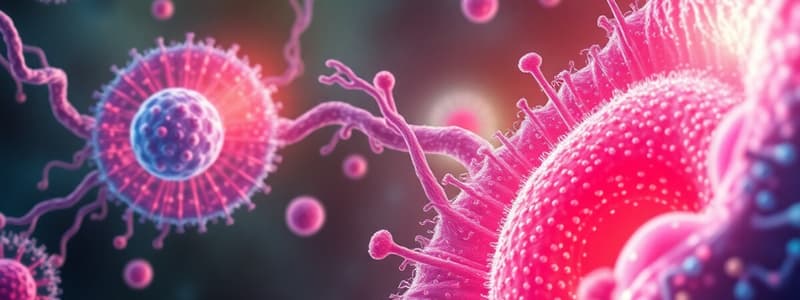Podcast
Questions and Answers
What is the primary function of the sarcoplasmic reticulum in muscle cells?
What is the primary function of the sarcoplasmic reticulum in muscle cells?
- Production of ribosomes
- Storage of calcium ions for muscle contraction (correct)
- Synthesis of secretory proteins
- Modification of macromolecules
What characterizes the Rough Endoplasmic Reticulum?
What characterizes the Rough Endoplasmic Reticulum?
- Storage of lipids
- Presence of ribosomes on its surface (correct)
- Site of carbohydrate breakdown
- Absence of protein synthesis
What role does the Golgi apparatus play in a cell?
What role does the Golgi apparatus play in a cell?
- Secretion of ribosomes
- Storage of cellular waste
- Synthesis of all lipids
- Modification and sorting of proteins from the ER (correct)
Which type of proteins are primarily synthesized in the Rough Endoplasmic Reticulum?
Which type of proteins are primarily synthesized in the Rough Endoplasmic Reticulum?
What do lysosomes primarily contain?
What do lysosomes primarily contain?
What is the primary role of the nucleus in a cell?
What is the primary role of the nucleus in a cell?
Which organelle is involved in the synthesis of ribosomal RNA?
Which organelle is involved in the synthesis of ribosomal RNA?
What is the process called that separates organelles and cell structures?
What is the process called that separates organelles and cell structures?
What structure controls the exchange of materials between the nucleoplasm and the cytoplasm?
What structure controls the exchange of materials between the nucleoplasm and the cytoplasm?
What type of RNA is involved in the formation of ribosomes?
What type of RNA is involved in the formation of ribosomes?
Where are free ribosomes located in a cell?
Where are free ribosomes located in a cell?
What is the maximum centrifuge speed required for ribosomes during cell fractionation?
What is the maximum centrifuge speed required for ribosomes during cell fractionation?
The material that comprises chromosomes, consisting of DNA and proteins, is referred to as what?
The material that comprises chromosomes, consisting of DNA and proteins, is referred to as what?
What is the primary function of bound ribosomes?
What is the primary function of bound ribosomes?
Which of the following is NOT a component of the Endomembrane System?
Which of the following is NOT a component of the Endomembrane System?
The Endoplasmic Reticulum (ER) is primarily responsible for which of the following?
The Endoplasmic Reticulum (ER) is primarily responsible for which of the following?
What is the role of the smooth Endoplasmic Reticulum (SER) in the cell?
What is the role of the smooth Endoplasmic Reticulum (SER) in the cell?
Which organelle is responsible for packaging proteins for secretion?
Which organelle is responsible for packaging proteins for secretion?
What property of the ER membrane allows it to separate the ER lumen from the cytosol?
What property of the ER membrane allows it to separate the ER lumen from the cytosol?
In liver cells, the smooth ER contributes to detoxification by:
In liver cells, the smooth ER contributes to detoxification by:
Cells that have high rates of protein synthesis typically contain what feature?
Cells that have high rates of protein synthesis typically contain what feature?
Flashcards are hidden until you start studying
Study Notes
Cell Structures and Functions
- All living organisms consist of one or more cells, the fundamental building blocks of life.
- Organelles are cellular materials that perform essential life functions.
- Cell Fractionation is a technique used to isolate organelles and structures in cells by centrifugation at varying speeds.
Centrifugation Speeds for Major Cell Structures
- Nucleus: 3,000 rpm for 5 minutes
- Mitochondria: 14,000 rpm for 7 minutes
- Ribosomes: 28,800 rpm for 16 hours
- Endoplasmic Reticulum: 35,000 rpm for 70 minutes
- DNA: 12,000 rpm for 2 minutes
The Nucleus
- Largest organelle and contains most of the cell’s DNA, directing protein synthesis.
- Nucleolus, located within the nucleus, synthesizes ribosomal RNA (rRNA) and assembles ribosomal subunits.
- Nuclear Envelope is a double membrane with nuclear pores regulating the movement of substances between the nucleus and cytoplasm.
- Nucleoplasm is the semi-solid fluid inside the nucleus, housing chromatin and the nucleolus.
Chromatin and Chromosomes
- Chromatin consists of DNA organized into chromosomes, which carry genetic information.
- Each chromosome contains a long DNA molecule associated with proteins (histones and nonhistones).
Ribosomes
- Composed of rRNA and proteins, facilitate protein synthesis in cells.
- Free Ribosomes, located in the cytosol, synthesize proteins that remain within the cell.
- Bound Ribosomes, attached to the endoplasmic reticulum, produce proteins for membrane insertion, organelle packaging, or secretion.
Endomembrane System
- Comprises structures that work together in protein synthesis, lipid transport, and detoxification.
- Key components: Nuclear Envelope, Endoplasmic Reticulum, Golgi Apparatus, Lysosomes, vesicles, and the Plasma Membrane.
Endoplasmic Reticulum (ER)
- A network of membranes, accounting for over half of cell membranes in eukaryotes.
- Divided into two types: Smooth ER and Rough ER.
Smooth Endoplasmic Reticulum (SER)
- Engages in lipid synthesis, carbohydrate metabolism, drug detoxification, and calcium ion storage.
- Important for producing lipids, including steroids and membrane phospholipids.
- Specialized in muscle cells as sarcoplasmic reticulum for calcium ion storage.
Rough Endoplasmic Reticulum (RER)
- Characterized by ribosomes on its surface, leading to a rough appearance.
- Synthesizes secretory proteins; for example, pancreatic cells produce insulin here.
- Proteins exit the ER in vesicles from a transitional ER region.
Golgi Apparatus
- Functions as a warehouse for sorting, modifying, and shipping ER products, especially proteins.
- Extensively involved in secretion, responsible for manufacturing some macromolecules.
- Synthesizes polysaccharides like pectin, incorporating them into plant cell walls.
Studying That Suits You
Use AI to generate personalized quizzes and flashcards to suit your learning preferences.




